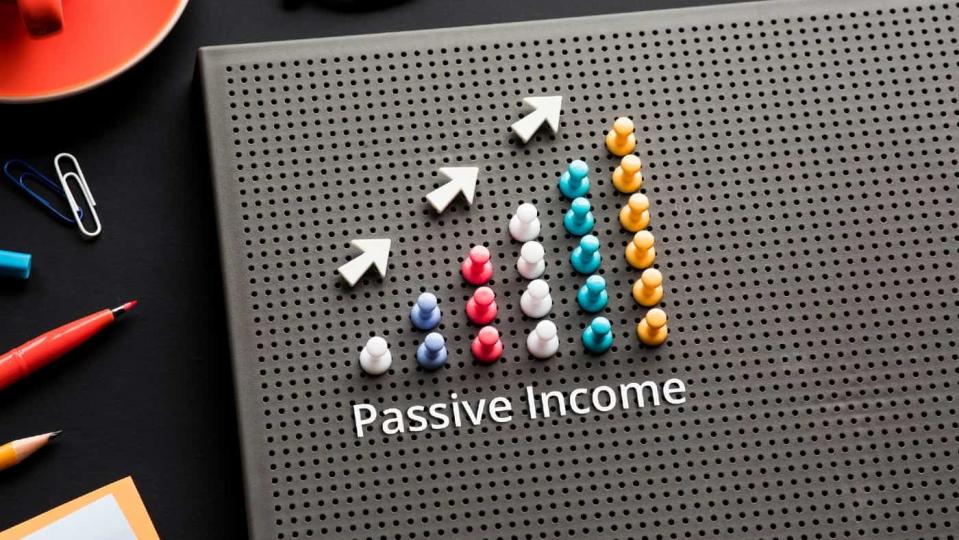Here’s how investing £10 a day could create passive income of £27,573 a year!

Buying dividend shares is a simple strategy investors can follow to generate passive income. Not only do they provide shareholders with regular cash payouts, but they also offer potential capital growth.
The average annual post-tax UK salary is £27,573 according to the latest ONS figures. I think it’s possible to generate that sum in dividend payouts by investing as little as £10 a day.
Here’s how I’d aim to achieve that goal.
Embracing risk
Dividend investing involves risks. Share prices can crash. Dividend income may not keep pace with inflation. Plus, dividend payments aren’t guaranteed since they can be cut or axed altogether.
Keeping a solid emergency fund in cash, carefully researching potential investments, and diversifying my portfolio across different companies and sectors are sensible ways of mitigating potential pitfalls.
However, ultimately investors need to become comfortable with risking their capital. After all, the other side of the coin is a potentially significant reward — a lifelong stream of substantial passive income.
Compound returns
So, how long would it take to earn £27,573 in annual passive income with £10 a day?
There’s no exact answer to this question. It’ll depend on my portfolio’s compound annual growth rate (CAGR) and the aggregated yield across my stock market holdings.
Currently, the average dividend yield for FTSE 100 stocks is 3.6%. Since I’d be investing exclusively in dividend shares, I’d aim for a higher overall yield of 5%.
That means I’d need a portfolio worth £551,460 to reach my target passive income stream. Even marginal improvements in my portfolio’s growth rate can drastically cut the time to build sufficient wealth, as the below table illustrates.
CAGR | Time taken |
|---|---|
4% | 49 years, 4 months |
6% | 39 years, 2 months |
8% | 33 years, 0 months |
10% | 28 years, 8 months |
Smart ways to boost my returns include reinvesting dividends and opting for commission-free brokers. I could also use a Stocks and Shares ISA to shelter my portfolio from the taxman or a SIPP for tax relief on my investments.
Please note that tax treatment depends on the individual circumstances of each client and may be subject to change in future. The content in this article is provided for information purposes only. It is not intended to be, neither does it constitute, any form of tax advice. Readers are responsible for carrying out their own due diligence and for obtaining professional advice before making any investment decisions.
Dividend ideas
Now, let’s consider which dividend stocks investors like me could buy.
High-yield shares have an obvious appeal, but they’re often riskier than Dividend Aristocrats with solid distribution histories.
Other options include exchange-traded funds (ETFs) or real estate investment trusts (REITs). Of course, there are considerable advantages to investing in a diversified mix of all the above.
For example, one dividend stock I own is FTSE 100 pharma giant GSK (LSE:GSK).
There’s plenty about the company to excite value investors. Its forward price-to-earnings (P/E) ratio of 10.3 is much lower than that of major competitors like AstraZeneca.
In addition, the 3.7% dividend yield is decent enough and crucially, forecast cover of 2.6 times earnings suggests there’s a healthy margin of safety.
Granted, the business faces its fair share of challenges. A recent US court ruling has allowed 75,000 personal injury lawsuits against the firm to progress, which could expose it to costly awards. The claimants allege that GSK’s heartburn drug Zantac causes cancer.
Litigation difficulties aside, GSK recently upgraded its full-year guidance. Demand for the company’s blockbuster medications for shingles, HIV, and respiratory illnesses should remain strong regardless of economic cycles.
Overall, I think it’s a stock worth considering for a diversified passive income portfolio.
The post Here’s how investing £10 a day could create passive income of £27,573 a year! appeared first on The Motley Fool UK.
More reading
Charlie Carman has positions in AstraZeneca Plc and GSK. The Motley Fool UK has recommended AstraZeneca Plc and GSK. Views expressed on the companies mentioned in this article are those of the writer and therefore may differ from the official recommendations we make in our subscription services such as Share Advisor, Hidden Winners and Pro. Here at The Motley Fool we believe that considering a diverse range of insights makes us better investors.
Motley Fool UK 2024

 Yahoo Finance
Yahoo Finance 